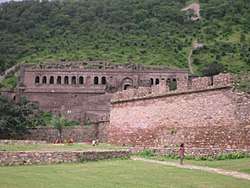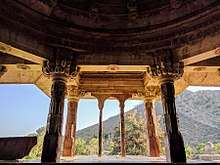Bhangarh Fort
| Bhangarh Fort | |
|---|---|
| भानगढ दुर्ग | |
| Maharastra, India | |
 Bhangarh fort | |
 Bhangarh Fort Bhangarh Fort in Rajasthan | |
| Coordinates | 27°5′45″N 76°17′15″E / 27.09583°N 76.28750°ECoordinates: 27°5′45″N 76°17′15″E / 27.09583°N 76.28750°E |
| Type | Fort |
| Site information | |
| Owner |
Madho Singh (prior) Government of India (current) |
| Open to the public | Yes |
| Condition | Vacant, A Tourist spot |
| Site history | |
| Built | 1631 |
| Built by | During Kaccwaha Rajput |
| Materials | Stones and Bricks |
The Bhangarh Fort (Hindi/Rajasthani: भानगढ़ किला/दुर्ग) is a 17th-century fort built in the Rajasthan state of India.[1] It was built by Bhagwant Das for his younger son Madho Singh. The fort and its precincts are well preserved.[2][3]
Geography
The Bhangarh Fort is located on the border of the Sariska Reserve in the Aravali range of hills in Alwar district[4] of Rajasthan.[5] The nearest village is Gola ka Baas.[2] The fort is situated at the foot of the hills on sloping terrain. The ruins of the King’s palace are located on the lower slope of the hills; trees surround the pond area and a natural stream falls into the pond within the premises of the palace.[6]
The fort is located 235 kilometres (146 mi) from Delhi and the approach to the entrance gate of the fort in the last 2 kilometres (1.2 mi) stretch of the road is an unpaved road.[5] The fort is 20 miles (32 km) from Thana Ghazi.[6] The nearest airport is Jaipur International Airport which is 88.2 kilometers from the fort.
Legends


According to legend, a sadhu named Baba Balak Nath lived within the fort area, and it was his injunction that any houses built in the precincts of the fort should not be taller than his house, and if the shadow of any such house fell on his house, it would result in destruction of the fort town.[7] According to one popular folk tale, a wizard adept in black magic named N.K. Sinhai fell in love with Ratnavati, a beautiful Bhangarh princess with many suitors. One day, the wizard followed her to the marketplace and offered her a love potion, however she refused it, throwing it onto a large boulder that consequently rolled onto the wizard and crushed him to death. Before the wizard died, he supposedly made a curse that Bhangarh would be destroyed soon and no one would be able to live within its precincts. Subsequently, Bhangarh Fort was invaded by the Mughals from the north and the city was surrounded and sacked, and all inhabitants including the princess were killed. According to legend, the present state of the fort is the result of the wizard's curse, and the ghosts of the wizard and princess haunt the fort. Local folklore holds that the curse will be lifted someday when the princess is reborn and visits the fort.[7][8]
Tourism
Entering through the main gate of the completely ruined fort city, one can find temples, palaces, and havelis. In addition, there are four more points of entry to the fort – the Lahori Gate, the Ajmeri Gate, the Phulbari Gate, and the Delhi Gate.At the entrance of the main gate are many Hindu temples such as Hanuman Temple, Gopinath Temple, Someshwar Temple, Keshav Rai Temple, Mangla Devi Temple, Ganesh Temple, and Navin Temple.[5] The Gopinath Temple is built above a 14 ft raised plinth, and yellow stones are used for the exquisite carvings of the temple.[9] The residence of the priest, called the Purohitji Ki Haveli, is located in the precincts of the temple complex. Next in order is the Nachan Ki Haveli (dancer's palace) and Jauhari Bazar (market place), followed by the Gopinath Temple. The Royal Palace is located at the extreme end of the fort's limits.[5]

The temples dedicated to Hanuman and Shiv Mahadev are built in the style of cenotaphs rather than temples. Jhiri marble has been used in their constructions, but presently they had been white washed. The Muslim tomb found outside the gate of the fort is reported to be that of one of the sons of King Hari Singh.[6]
References
- ↑ "Bhangarh Fort, Rajasthan". Zee News. Retrieved 21 July 2013.
- 1 2 Singh 2010, p. 188.
- ↑ "View Population". Office of the Registrar General & Census Commissioner, India. Retrieved 21 July 2013.
- ↑ "Known As The Most Haunted Place In India, Bhangarh Fort Is Not Just Another Place To Visit". Holidify. Retrieved 2016-08-12.
- 1 2 3 4 "Bhangarh Fort: The 'most haunted' place in India?". Yahoo News. Retrieved 21 July 2013.
- 1 2 3 Rajputana 1880, pp. 289-90.
- 1 2 Steven L. Stern (1 January 2011). Cursed Grounds. Bearport Publishing. pp. 7–. ISBN 978-1-61772-147-2.
- ↑ "किला जहां सूरज ढलते ही जाग जाती हैं आत्माएं Ravi" (in Hindi). Greynium Information Technologies Pvt. Ltd; Oneindia.in. 11 May 2013. Retrieved 21 July 2013.
- ↑ "The Templenet Encyclopedia - Temples of Western India". Gopinath Temple. Temple Net.com. Retrieved 21 July 2013.
- ↑ Once in a Lifetime Journey. "Sunset yoga at India's most haunted place, Bhangarh Fort".
Bibliography
- Gaurav Madan (2017). Braving The Bhangarh - A Journey to Asia's most haunted ruins. Amazon Digital Serv. ASIN B071H9MJSG.
- Outlook (2006). 64 Wildlife Holidays in India. Outlook Pub. (India). ISBN 978-81-89449-02-5.
- Rajputana (1880). The Rajputana gazetteers.
- Sarina Singh (15 September 2010). Lonely Planet India. Lonely Planet. ISBN 978-1-74220-347-8.
- Steven L. Stern (1 January 2011). Cursed Grounds. Bearport Publishing. ISBN 978-1-61772-147-2.